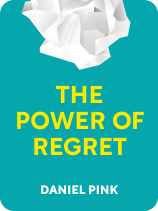

This article is an excerpt from the Shortform book guide to "The Power of Regret" by Daniel Pink. Shortform has the world's best summaries and analyses of books you should be reading.
Like this article? Sign up for a free trial here.
What is the psychology of regret? How is regret a process?
In The Power of Regret, Daniel Pink explains that the process of regret involves three steps. These steps include telling a story about the past, inventing a new story about an alternative past, then comparing the two.
Let’s learn more about the psychology of regret by analyzing its process.
Step #1: Telling a Story About the Past
Pink explains that the first thing to understand about the psychology of regret is that it starts with a story about a person’s past. He suggests that we as humans are unique in our ability to tell stories and to “time travel” in our imaginations. We begin the process of regret by creating a narrative about something we did or didn’t do in the past.
(Shortform note: Psychologists explain that the story you tell about yourself changes throughout your life. Storytelling is a way of reconciling past events with your present self-image. Storytelling also plays an important role in defining your trajectory in life—your sense of where you’re going and where you’ve been. Therefore, the story you tell yourself about your past may not be an accurate reflection of events, but rather a reflection of how you feel and think about your life in the present.)
Step #2: Imagining an Alternative Story
Pink explains that the second step in the process is creating a new narrative in which you behaved differently in the past. You imagine that your life in the present is different because your past self acted differently.
If your original story was about a poor decision you made or an opportunity you let slip through your fingers, this alternative story is a fantasy where you made the opposite decision or took advantage of the opportunity. In the alternative story, your life played out differently because of this change in the past. At this point in the process, you haven’t yet compared the two stories—you’ve simply created them.
(Shortform note: Understanding the psychology behind daydreaming and fantasy can help explain why we tell alternative stories. Researchers have found that people often daydream hypothetical solutions to problems they can’t solve in their current lives. This is why daydreams often feel like wishful thinking: They show us a world in which problems like isolation, lack of career advancement, or failed romantic relationships have been resolved. Therefore, imagining alternative stories of your past self may be a way of exploring hypothetical solutions to the real problems you’re struggling with now.)
Step #3: Comparison and Evaluation
Pink explains that you complete the process by comparing and evaluating the two presents. You’ll then decide which one you like better: your current life (original story) or the alternative present (alternative story). This stage has two potential outcomes, and one of them leads to regret.
Outcome 1: You like your actual life more than your imagined life. This comparison will produce a sense of relief that you’ve avoided a worse fate than your current life. However, this outcome is extremely rare because most people are more inclined to dwell on what could have gone better in their lives than what could have gone worse. Outcome 1 occurs most often with people who have had near-death experiences or survived natural disasters.
Outcome 2: You like your imagined life more than your actual life. When you see that you’re happier and more fulfilled in the imagined scenario than in your current life, you may feel a sense of pain, loss, or grief. You then attribute this feeling to the decision you made in your first story, leading you to experience regret. For example, if you have a relative who recently passed away and you didn’t spend much time with them, you may think, “If only I’d reached out to this relative sooner, I would have had this relationship in my life.” Pink explains that this second outcome is far more common than the first.
| Understanding Negativity Bias In understanding why the second outcome (liking the alternative present more than the real present) occurs so much more often than the alternative (liking your real present more than the alternative), it helps to explore something psychologists call negativity bias. Researchers have found that people are far more attentive to negative parts of their lives than positive ones. They remember painful interactions more often than enjoyable ones, spend more time thinking about the distressing parts of their lives than parts of their lives going well, and will pay more attention to bad news than good news. Psychologists argue the explanation lies in evolution. Human minds are fine-tuned to focus on dangers and threats so that people can overcome them and survive. Therefore, it’s no surprise that people will focus more on the parts of their lives that didn’t turn out well than the parts that did. |

———End of Preview———
Like what you just read? Read the rest of the world's best book summary and analysis of Daniel Pink's "The Power of Regret" at Shortform.
Here's what you'll find in our full The Power of Regret summary:
- A look at why most people feel regret, and what causes it
- The three worst ways to deal with regrets
- The five-step process for turning regrets into advantages






